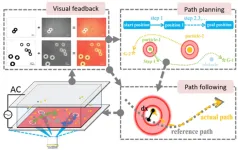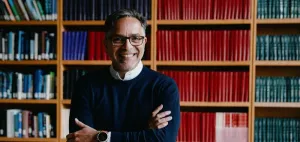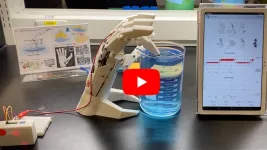A new model offers an explanation for the huge variety of sizes of DNA in nature
Why is "junk DNA" not deleted from the original genome over millions of years of evolution?
2023-02-22
(Press-News.org)
Why is "junk DNA" not deleted from the original genome over millions of years of evolution?
A new model offers an explanation for the huge variety of sizes of DNA in nature
Unlike "junk email" that is immediately deleted from the email box, "junk DNA" continues to exist in living creatures in nature such as bacteria, insects, and even mammals such as humans, alongside the original genome and thus the genome grows throughout evolution.
The researchers' explanation: the "junk DNA" hides in functional areas, thus deletions are likely to damage the functional DNA and therefore are rejected by evolution.
A new model developed at Tel Aviv University offers a possible solution to the scientific question of why neutral sequences, sometimes referred to as "junk DNA", are not eliminated from the genome of living creatures in nature and continue to exist within it even millions of years later.
According to the researchers, the explanation is that junk DNA is often located in the vicinity of functional DNA. Deletion events around the borders between junk and functional DNA are likely to damage the functional regions and so evolution rejects them. The model contributes to the understanding of the huge variety of genome sizes observed in nature.
The phenomenon that the new model describes is called by the team of researchers "border induced selection". It was developed under the leadership of the PhD student Gil Loewenthal in the laboratory of Prof. Tal Pupko from the Shmunis School of Biomedicine and Cancer Research, Faculty of Life Sciences and in collaboration with Prof. Itay Mayrose (Faculty of Life Sciences, Tel Aviv University). The study was published in the journal "Open Biology".
The researchers explain that throughout evolution, the size of the genome in living creatures in nature changes. For example, some salamander species have a genome ten times larger than the human genome.
Prof. Pupko explains: "The rate of deletions and short insertions, which are termed in short as 'indels', is usually measured by examining pseudogenes. Pseudogenes are genes that have lost their function, and in which there are frequent mutations, including deletions and insertions of DNA segments. In previous studies that characterized the indels, it was found that the rate of deletions is greater than the rate of additions in a variety of creatures including bacteria, insects, and even mammals such as humans. The question we tried to answer is how the genomes are not deleted when the probability of DNA deletion events is significantly greater than DNA addition events."
PhD student Loewenthal says: "We have provided a different view to the dynamics of evolution at the DNA level. As mentioned, when measuring the rate of indels there will be more deletions, but the measurements are carried out in pseudogenes which are quite long sequences. We claim that in shorter neutral segments, deletions are likely to delete adjacent functional segments which are essential for the functioning of the organism, and therefore will be rejected. We call this phenomenon "border-induced selection". If so, when the segment is short, there will be a reverse bias so that there will be more insertions than deletions, and therefore short neutral segments usually are retained. In our study, we simulated the dynamics of indels, while taking into account the effect of "border-induced selection” and compared the simulation results to the distribution of human intron lengths (introns are DNA segments in the middle of a protein-coding gene, which themselves do not code for a protein). A good match was obtained between the results of the simulations and the distribution of lengths observed in nature, and we were able to explain peculiar phenomena in the length distribution of introns, such as the large variation in intron lengths, as well as the complex shape of the distribution which does not look like a standard bell curve."
Link to the article:
https://royalsocietypublishing.org/doi/10.1098/rsob.220223
END
[Attachments] See images for this press release:


ELSE PRESS RELEASES FROM THIS DATE:
2023-02-22
San Antonio – Feb. 22, 2023 – Southwest Research Institute and ITS Texas are inviting college students and young professionals to participate in the inaugural Future Leaders Program at the 2023 ITS America Conference & Expo April 24-27 in Grapevine, Texas.
The new program is designed to inspire the next generation of leaders in the intelligent transportation systems (ITS) industry through a variety of activities at the ITS America Conference & Expo, which takes place this year at the Gaylord Texan Resort. Participants can attend education sessions and training and network with ITS professionals, exhibitors, sponsors and technology providers.
“The ...
2023-02-22
A research paper by scientists at the Beijing Institute of Technology proposed an automated manipulation method for transporting microparticles actuated by optoelectronic tweezers (OETS).
The new research paper, published in the journal Cyborg and Bionic Systems, developed a dynamic control framework for synchronously discretized manipulation of multiple microparticles. Differentiated motion decisions are formulated for each micro target based on the corresponding state and environmental information in real time, so that all controlled targets can reach their goal positions safely and accurately. The motion of microparticle is controlled through dynamic modulation ...
2023-02-22
New research from the University of Missouri School of Medicine has established a link between irritable bowel syndrome (IBS) and mental health challenges, such as anxiety, depression, and suicidal ideation. The research highlights the need for health professionals to evaluate and treat associated psychiatric co-morbidities in IBS patients to improve their overall health and quality of life.
IBS is a chronic disorder of the stomach and intestines affecting up to 15 percent of the population. It causes cramping, abdominal pain, bloating, gas, and diarrhea. This study looked at more than 1.2 million IBS patient hospitalizations from 4,000 U.S. hospitals over a three-year ...
2023-02-22
Mistletoe extract has been widely used to support cancer therapy and improve quality of life, but there has been a lack of clinical trials and data to support its use. Researchers at the Johns Hopkins Kimmel Cancer Center completed what is believed to be the first phase I trial of intravenous Helixor M in the U.S. aimed at determining dosing for subsequent clinical trials and to evaluate safety.
The findings from the small study were reported online Feb. 9 in Cancer Research Communications.
The trial’s ...
2023-02-22
PATERSON, N.J.—The first-ever casebook on ultrasound-guided vascular access procedures offers practical solutions to complex bedside challenges with an emphasis on improving patient safety. Now available from Springer Publishing, the casebook features 50 chapters highlighting clinical challenges and evidence-based solutions for everything from peripheral to tunneled central lines in neonatal, pediatric, and adult patient populations.
Ultrasound-Guided Vascular Access: Practical Solutions to Bedside Clinical Challenges is coauthored by vascular access expert Matthew D. Ostroff, MSN, APN, and world-renowned cardiac surgeon Mark Connolly, MD, ...
2023-02-22
Like an old man suddenly aware the world has moved on without him, the conifer tree native to lower elevations of California’s Sierra Nevada mountain range finds itself in an unrecognizable climate. A new Stanford-led study reveals that about a fifth of all Sierra Nevada conifer forests – emblems of Western wilderness – are a “mismatch” for their regions’ warming weather. The paper, to be published Feb. 28 in PNAS Nexus, highlights how such “zombie forests” are temporarily cheating death, likely to be replaced with tree species ...
2023-02-22
Researchers from Boston College, Georgetown University, American University, Texas A&M University, and Colorado State University published a new Journal of Marketing article that challenges the entrenched belief that financial vulnerability only affects low-income consumers.
The study, forthcoming in the Journal of Marketing, is titled “Beyond Income: Dynamic Consumer Financial Vulnerability” and is authored by Linda Court Salisbury, Gergana Y. Nenkov, Simon J. Blanchard, Ronald Paul Hill, Alexander L. Brown, and Kelly D. Martin.
Even pre-pandemic, many U.S. workers lived ...
2023-02-22
For his contributions to the field of regeneration, Alejandro Sánchez Alvarado receives the Vilcek Prize in Biomedical Science. The Vilcek Prize in Biomedical Science is a $100,000 prize awarded annually by the Vilcek Foundation as part of its prizes program.
Awarded annually since 2006, the Vilcek Foundation prizes recognize and celebrate immigrant contributions to scientific research and discovery, and to artistic and cultural advancement in the United States. The prizes provide direct support to individual immigrant scientists and artists and help to raise greater public awareness of the value of immigration ...
2023-02-22
People are occasionally exposed to potentially harmful substances in the environment or through their diets or habits. For example, a compound found in cigarette and industrial smoke, benzo(a)pyrene (BaP), is known to damage DNA. Now, researchers reporting in ACS Central Science have mapped these effects — down to the single-nucleotide level — for the first time in human lung cells after BaP exposure. They say that this technique could help predict exposures that lead to cancers.
When BaP gets into a person’s body and is metabolized, it can turn into a new compound, or metabolite, that irreversibly attaches to one ...
2023-02-22
Although many measures are in place to prevent contamination, pollutants, such as mercury and lead, can still end up in the environment. Sensing them often requires complicated processes, but what if you could detect them with the tap of a fingertip? Researchers reporting in ACS Nano have developed a self-powered nanosensor that can discover small amounts of mercury ions and immediately report the result. Watch a video of the nanosensor in action here.
Mercury in its Hg2+ form can be harmful if consumed through contaminated water or food, so researchers have developed various mercury sensors. One ...
LAST 30 PRESS RELEASES:
[Press-News.org] A new model offers an explanation for the huge variety of sizes of DNA in nature
Why is "junk DNA" not deleted from the original genome over millions of years of evolution?





